What is Tooth Filling?
A filling is a way to restore a tooth damaged by decay back to its normal function and shape. Before filling up the cavity, the dentists will need to remove the softened and diseased (infected) portion of the tooth.
Once cleaned of infected tooth structure, the cavity can then be filled with the appropriate materials for that particular tooth. By closing off the space with a filling, further decay is prevented as it stopped the bacteria entry and food trap.
The filling also restores the shape and function of the tooth thus restoring back the esthetic and chewing function of the tooth.
Why Should You Do a Tooth Filling (When You Need To)?


If too much tooth structure is lost, a crown may be the next option of restoring the shape and function of the tooth.
Untreated cavity will get deeper and starts to infect the nerve (pulp) of the tooth and lead to its eventual death of the tooth.
A dead tooth requires either a root-canal treatment (followed by a crown to protect the fragile remaining tooth structure) or removed by an extraction.
How Long Does Doing a Tooth Filling Take?


Types of Tooth Fillings
Composite (plastic) resins are tooth-coloured and therefore used where a natural appearance is desired. For larger fillings, composites may not be the most ideal material as they may wear down or chip over time. They can become stained from coffee, tea or tobacco.
They do not last as long as other types of fillings, with a lifespan of about 5-7 years.
Amalgam (silver) fillings are durable and resistant to wear and tear. However, because of their metallic silver colour, they are usually used on the back teeth where esthetic is not critical. It can last much longer than composite resin, around 10-15 years
Gold fillings are made-to-order in a laboratory before they can be cemented into place. Gold inlays are long-lasting but more expensive and also require multiple visits.
Porcelain fillings are called inlays or onlays. They are also produced in a lab before being bonded to the tooth. They can be colour matched to the tooth and are resistant to staining.
How Long can a Tooth Filling Last?
The average life span of a filling depends on the material used. An amalgam (silver) filling can last about 10-15 years while the tooth coloured fillings like composite resin can last about 5-7 years. In order to maximise the life span of the fillings, good oral hygiene is compulsory. Many of the fillings will fail because of mechanical fracture or wear and tear due to the heavy chewing forces.
The life span of the filling can be shortened due to poor hygiene as new decay occur at the junction between the tooth structure and the filling or abusive use of the restored tooth by biting on hard stuff like ice, bone and crab shell.
Types of Dental Crowns
Dental crowns are classified depending on its material:
- All Porcelain Crown – pure ceramic material.
- All Metal Crown – purely metal, normally gold or cobalt-chromium.
- Porcelain Fused to Metal Crown – a porcelain veneer is fused to an inner metal shell
- Temporary/Plastic Crowns – temporarily used while waiting for the permanent crown to be fitted.
Our dentists will recommend you the appropriate crown for the right clinical situations in regards to aesthetic, functional and longevity factors.
Is the Procedure For a Tooth Filling Painful?
The amount of discomfort or pain depends on the depth of the cavities and the vitality of the tooth. If it is shallow and confined to the enamel layer (outermost layer of the tooth), then you will be unlikely to feel any pain during the drilling.
This layer of the tooth is a “dead” layer without any nerve, thus it is almost like cutting hair or nail.
If the cavity is deeper and located in the dentin layer of the tooth which is heavily populated with nerves, then drilling this portion is sensitive. This procedure can be made painless with the application of a local anaesthetic to numb the tooth.
Numbing the tooth while doing a filling will make the dental treatment much more comfortable and relaxing for you and also let our dentist do a better job of cleaning out the infected portion of the tooth without causing you pain.
Filling root-canal treated tooth is a totally painless procedure as the nerve (pulp) of the tooth has been removed. No nerves in the tooth mean no ability to feel pain during the filling procedure.
When the anaesthesia wears off, the tooth with the filling may feel sensitive sometimes but this sensation will not last long and be gone in a few days. The tooth is adapting to the presence of the new filling.
FAQs
Which type of filling is the best?
There is no such thing as the best filling material as each material has its strengths and weaknesses. The choice of the filling depends on a few factors like the extend of the repair, the location of the filling and oral hygiene standard of the patient. Our dentist will glad to discuss with you the choices of fillings that are suitable for your particular condition.
Will I experience sensitivity after filling?
The tooth with a new filling may feel more sensitive to hot/cold or pressure on biting. This may last for a few days and it is normal as the tooth is adjusting to the new filling. If this sensitivity persist for more than 1-2 weeks, it may be good to come back and let our dentist take a look to find out cause of this unusual sensation.For tooth with deeply placed filling, sometime the germs may already enter the pulp and can cause the tooth to die despite that the filling is well placed. This just meant that the treatment came a bit too late. Alternative treatment to the painful tooth is either a root canal treatment or extraction.
Can I request for anaesthetic when doing filling?
Yes, you can. Our dentists will be happy to provide you with local anaesthetic upon request. A relaxed patient on our chair will make our dentists work much more comfortable and less stressful.
I have a cracked tooth. Can I do a filling instead of crown?
A filling does not repair a crack on the tooth or hold the remaining structure together. Instead, a filling behaves like a wedge, trying to split the cracked tooth every time you bite on it. A crown has a protective function like a tooth wearing a helmet, protecting it against splitting the tooth compared to the wedging effect of a normal filling. If the filling is very large, it can cause the remaining structure of the weakened tooth to break and risk making it irreparable or resulting in a catastrophic split on the tooth.

